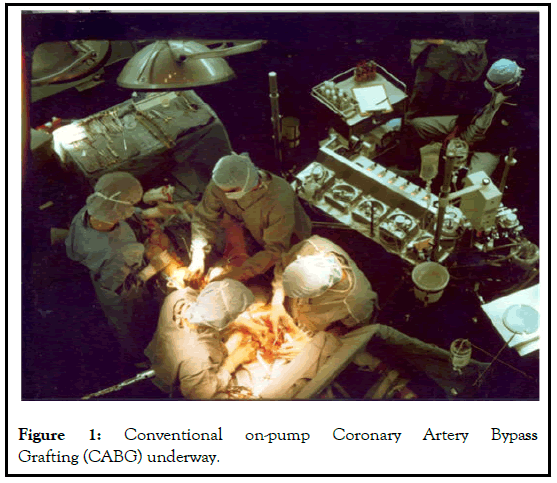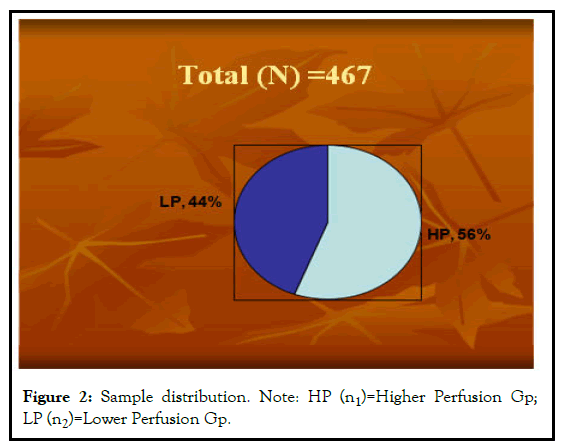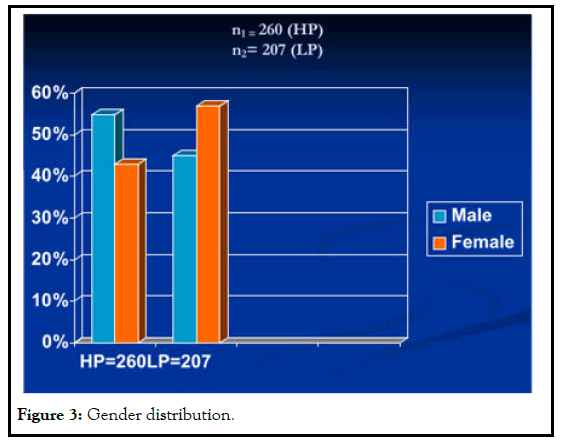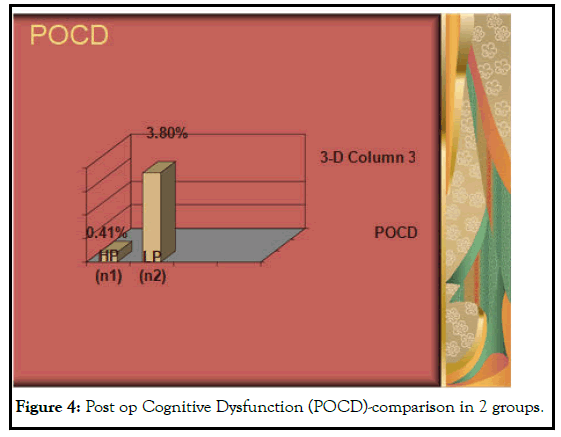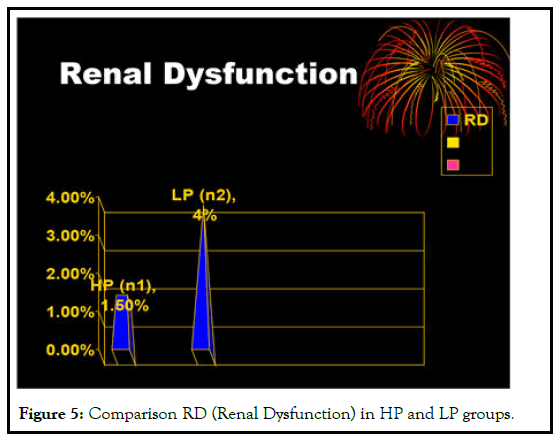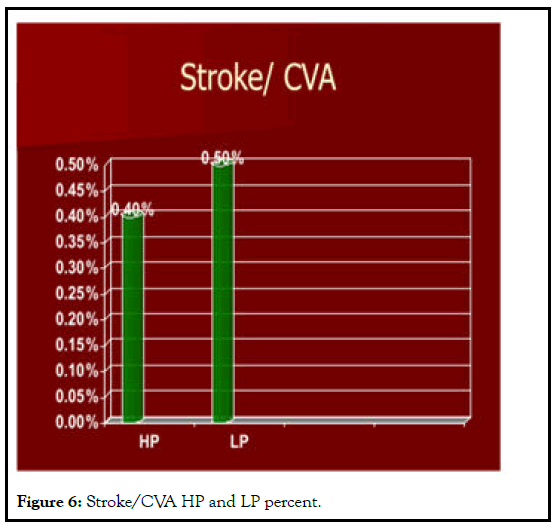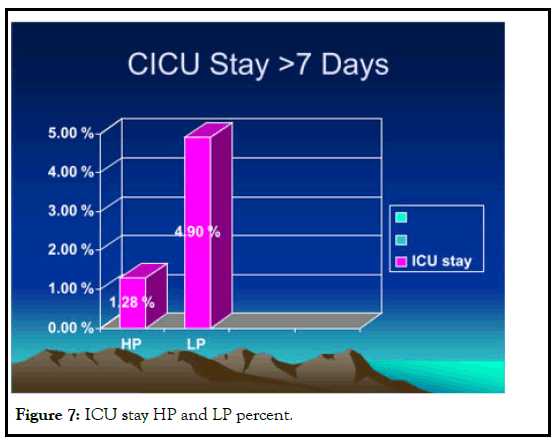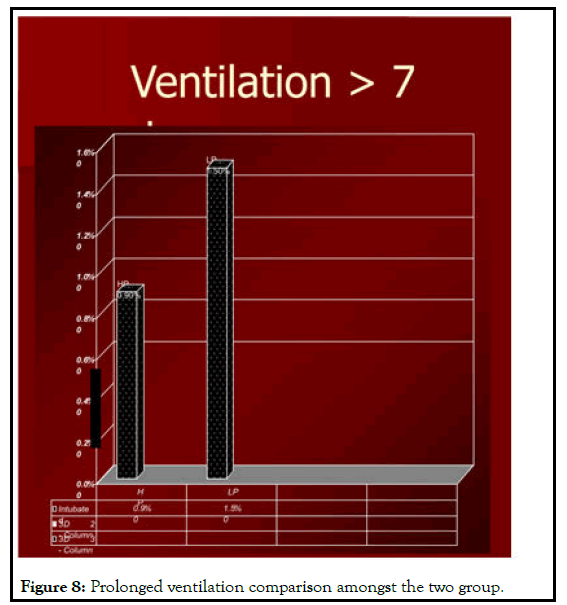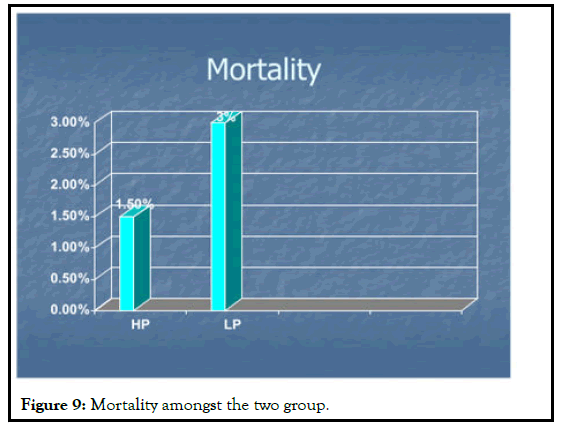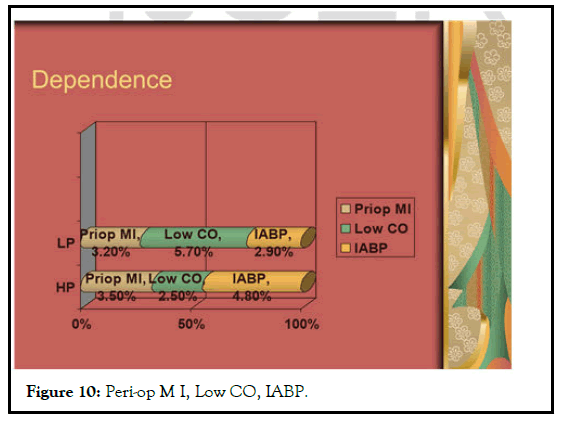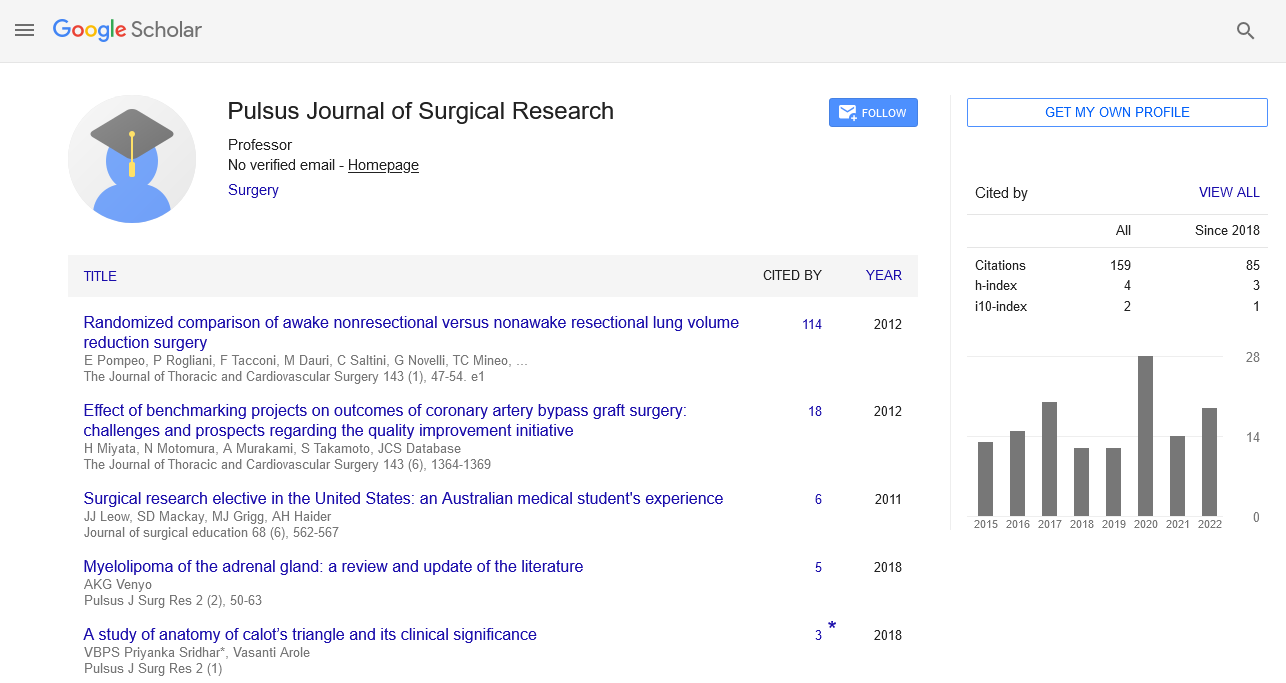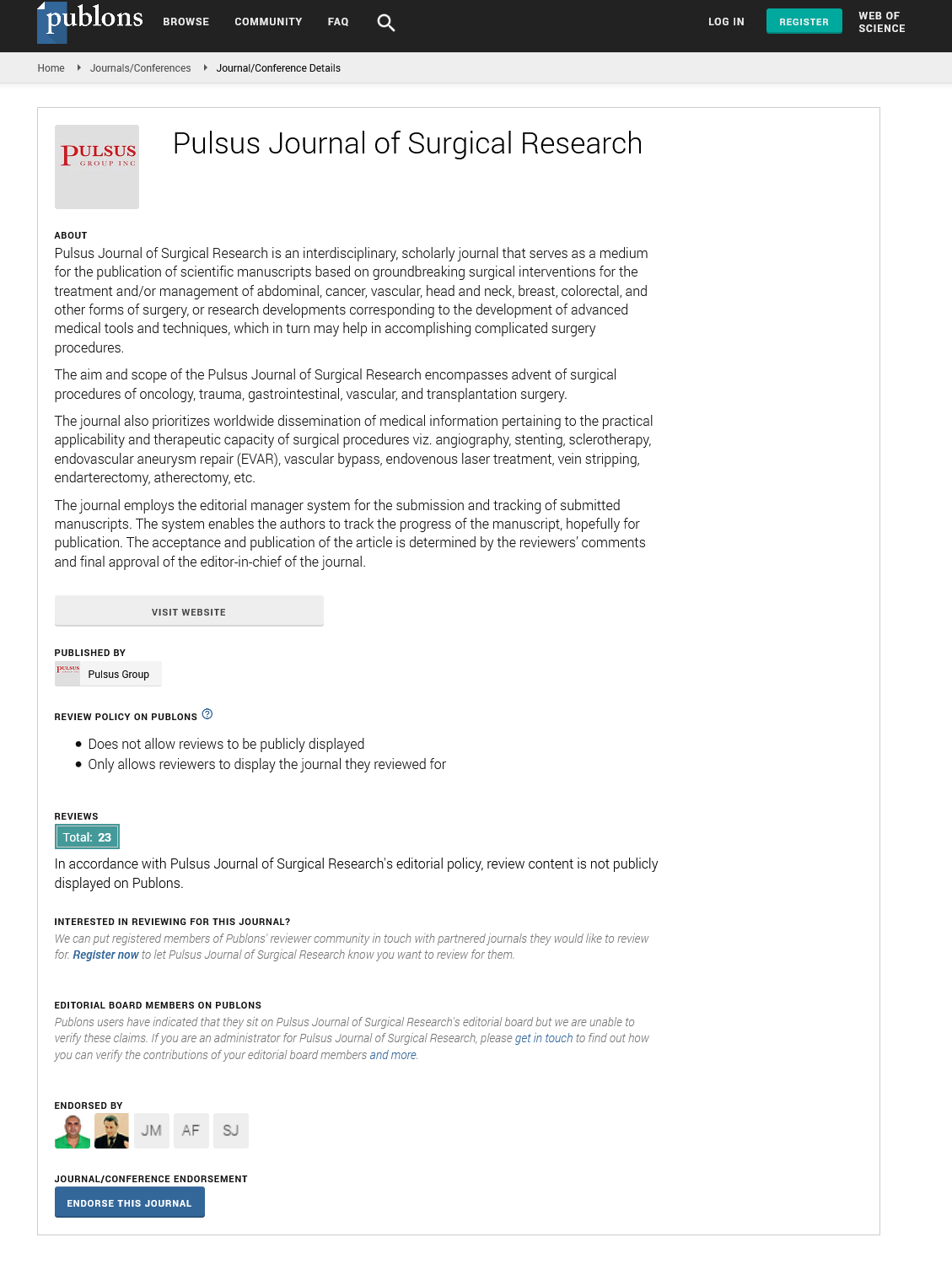Comparison of perioperative perfusion pressures in terms of postoperative morbidity in cardiac surgery
Received: 30-Mar-2023, Manuscript No. PULPJSR-23-6677; Editor assigned: 04-Apr-2023, Pre QC No. PULPJSR-23-6677 (PQ); Reviewed: 18-Apr-2023 QC No. PULPJSR-23-6677; Revised: 03-Jul-2023, Manuscript No. PULPJSR-23-6677 (R); Published: 31-Jul-2023
Citation: Anwar S. Comparison of perioperative perfusion pressures in terms of postoperative morbidity in cardiac surgery. J Surg Res 2023;7(2):1-6.
This open-access article is distributed under the terms of the Creative Commons Attribution Non-Commercial License (CC BY-NC) (http://creativecommons.org/licenses/by-nc/4.0/), which permits reuse, distribution and reproduction of the article, provided that the original work is properly cited and the reuse is restricted to noncommercial purposes. For commercial reuse, contact reprints@pulsus.com
Abstract
In cases undergoing elective coronary surgery, the continuum of perfusion pressures were contrasted in terms of renal dysfunction, neurological impairment or stroke, ICU stay, and mortality. It was a prospective research that ran from March 2014 until February 2017. Total patients (N=467) underwent on-pump Coronary Artery Bypass Grafting (CABG) for 3 vessel coronary artery disease (VCAD=55%), Left Main Stem (LMS=18%), left main equivalent/proximal Left Anterior Descending artery (LAD) lesions (17%), Non-ST-Elevated Myocardial Infarction (NSTEMI) with ongoing ischemia (2.5%), 1-2 Vessel Coronary Artery Disease (VCAD) SPSS 16.0 was used to conduct the statistical analysis.
When compared to the (n1) group, the (n2) group's longer ICU (Intensive Care Unit) stay (>7 days) was substantially higher (p0.05). Lower perfusion (n2) group: 3% mortality; Higher perfusion (n1) group: 1.5% mortality. In the lower perfusion-group, renal dysfunction (Stage 2-3 RIFLE criteria) and postoperative neurological damage were found to be statistically significant. However, there was no discernible difference between the two groups in terms of the frequency of strokes (p=0.09). For two groups, ambiguous information was gathered on the needs for mechanical inotropic support, low Cardiac Output (CO) and perioperative MI. Though it never reached statistically significant levels (p>0.05), the Lower perfusion group (n2) did have somewhat increased ventilatory dependence (>5 days). The whole study was favourable for higher perfusion pressures on-pump for better CABG surgery.
Keywords
Coronary artery bypass grafting; Perfusion pressures; Renal dysfunction; Neurological injury; ICU stay; Intra Aortic Balloon Pump (IABP) requirement; Mortality; Stroke; Low CO, Prolongedventilation; Post-Operative Cognitive Dysfunction (POCD)
Introduction
Coronary surgery no doubt has evolved to the umpteen standards of unbelievable miraculous developments over the second half of the last century, but conventional on-pump CABG still remains the most widely disseminated choice of surgeons around the world today. The perfusion pressures on-bypass perioperatively have had been the point of debate for the past four decades with slightly ambivalent picture glooming around the precise perfusion pressures, though strong evidence and weight of statistics hangs in favor of higher Periop-perfusion pressures for better outcomes in coronary cases in terms of overall morbidity, neurological outcomes and post- bypass renal recovery. The associated neurological injury including (Type I and II neurological deficits) although mostly have had been attributed to micro-embolization on Cardiopulmonary Bypass (CPB), lower perfusion pressures which off-course have also been under constant kaleidoscopic panorama, have had been extensively studied and recently alluded to as possible determinant of myriad of neurological injuries including cerebral gross infarcts as well as watershed infarcts proven on imaging modalities by few studies. These neurological deficits (including type 1 and 2 deficits) have been reported as 1%-5% incident as per world over contemporary data regarding on-CPB coronary cases. The prevalent data is indicative of far greater prevalence of type II neurological deficits and cognitive decline in relation to on-pump cerebral hypoperfusion/ischemia than the type I deficits and Cerebro-Vascular Accidents (CVA). Whereas type I neurological deficits are mostly attributed to embolic phenomenon on CPB. Although cerebral ischemia has not been advocated for Mean Arterial Pressures (MAP) as low as 45 mmHg-50 mmHg until brain autoregulatory mechanisms are normally functional, yet the accepted guidelines and recommendations world wide are incumbent upon perfusing MAP pressures be ideally 70 mmHg and even higher for patients with comorbids like hypertension, renal dysfunction or significant neurological history.
The association of possible visceral ischemia, renal hypoperfusion, post clamp myocardial dysfunction and prolonged ICU stay has been well enumerated in recent and previous efforts to identify on-CPB perioperative hypo-perfusion as one of the culprits, but it could not be confidently beleaguered and addressed as the precise causal-effect perpetrator [1]. The current study included all of the variables/multi-system/viscera that could be affected by systemic hypo-perfusion perioperatively on CPB, such as cerebral/neurological dysfunction, perioperative MI, Low CO, renal dysfunction, prolonged ventilatory reliance and ICU stay.
The close proximity of temperature and perfusion pressures and CPB flows, as well as their effect on perfusion pressure requirements of end organs such as kidneys and brain, was adequately addressed by our surgical team's monotonous routine of performing all elective and emergency coronaries at mild hypothermia by drifting at around 32 degrees Celsius (C) and maintaining pump Flows on average at 2L-4L/min based on Body Surface Area (BSA).
Materials and Methods
It was a three-year prospective study that took place between March 2014 and February 2017. Tahir heart institute in Faisalabad, Pakistan, followed a total of 467 patients. Only a few patients were included from our surgical team's other private facilities, including Quaid-e-Azam hospital and Bahria phase-8 hospital cardiac units in Rawalpindi, Pakistan. All CABG patients (Figure 1) were randomly assigned to one of two groups. Higher Perfusion (HP) pressures on-CPB (HP Group) were assigned to group I (n1=260). Lower Perfusion (LP) pressure-patients on-pump perioperatively (n2=207). HP was classified as greater than 75 mmHg and LP as less than 70 mmHg (60 mmHg-69 mmHg). Renal dysfunction was defined as any renal profile/ derangement that met the RIFLE (Risk Injury Failure Loss and End stage kidney disease classification system) criteria of stage 2-3 or higher.
Preoperative neurological evaluation included a complete history, physical neurovascular and carotid examination and carotid Doppler studies for all those who were indicated (Left Main Stem (LMS), LM Equivalent, PVD (Peripheral Vascular Disease), diabetics, positive carotid bruits, age >60 yrs, and significant past neurological history). Aside from that, pre-Op CT Scan Brain for patients with a history of CVA/stroke was frequently conducted.
All patients underwent a bedside Mini-Mental State Examination (MMSE) for neurological and cognitive assessment both pre- and post-operatively [2]. Patients having gross infarcts, CVA, previous strokes or pre-operative cognitive deterioration were excluded from the trial. CVA/stroke were defined as cerebrovascular/neurological injury/deficit with clinically obvious signs or documented evidence on CT/MRI.
Figure 1: Conventional on-pump Coronary Artery Bypass Grafting (CABG) underway.
POCD was classified as being below the 70th percentile on the MMSE and cognitive and personality testing. Pre-op CVA/stroke, cognitive dysfunction, pre-op renal dysfunction, grade -4/5 Aortic (Ao) atherosclerotic disease, and severe debilitating Chronic Obstructive Pulmonary Disease/COPD (Only mild-moderate COPD patients with pulmonary function tests/PFTs >60% and PaO2 >65% on room air and/OR stable either on mobile supplemental oxygen or inhaled steroids and with no signs of acute distress, ARDS Similarly, generalised PVD patients were included, as were a small number of carotid disease and grade 1-2 Ao illness patients.
PVD was graded and labelled based on clinical vascular examination and imaging investigations, whereas carotid disease was labelled solely for patients who had severe carotid stenosis >75% as proven by Carotid Doppler or Angiography.
All CABGs were performed by standard median sternotomy incisions with Ao and 2 stage atrial cannulation and standard on-CPB with standard full dose Heparinization. CABG was conducted on a fully stopped heart with tepid blood cardioplegia and systemic hypothermia at 32°C [3]. All cases were completed on biocompatible circuits with membrane oxygenators and micro-bubble filters. All cases in the study were routinely cannulated with standard Ascending Aortic (AAo) cannulas (chosen according to BSA and Flow requirements on pump).
The pre-op characteristics of patients from both groups are listed in the table below. In Table 1. A prolonged ICU stay was defined as a Cardiac ICU (CICU) stay of more than seven days. Although it was later added as a secondary outcome in the study, any in-hospital death (perioperative or postoperative) within 1 year of surgery owing to a cardiac condition was considered Mortality. Prolonged ventilator reliance was defined as staying in the CICU for more than 5 days [4]. All acquired data and comparisons between two groups were computed and analysed using SPSS 16.0 and the results were tabulated and visually depicted.
| Variables | Higher Perfusion/HP (56%) n1=260 |
Lower Perfusion/LP (44%) n2=207 | p‑Value |
|---|---|---|---|
| Age >70 | 10% | 2% | 0.03 |
| <70 (60-69) | 50% | 48% | 0.07 |
| <60 | 40% | 50% | 0.06 |
| Male (65%) | 55% | 45% | 0.07 |
| Female (35%) | 43% | 57% | 0.06 |
| NYHA class I-II (92%) | 60% | 40% | 0.08 |
| 3VCAD (55%) | 27% | 28% | 0.09 |
| 1-2VCAD (5%) | 4.5% | 0.5% | 0.04 |
| LMS (17%) | 10% | 7% | 0.07 |
| LM equivalent (18%) | 9% | 9% | 0.08 |
| (All with fair/Good LV) | |||
| Afib (5%) | 5% | 3% | 0.06 |
| Peripheral Vascular Disease (PVD) (12%) |
5% | 7% | 0.07 |
| Carotid disease (7%) | 3% | 4% | 0.08 |
| Grade 4-Ao disease | - | - | - |
| Preop renal dysfunction | - | - | - |
| DM (70%) | 75% | 25% | 0.03 |
| HTN (41%) | 65% | 35% | 0.04 |
| EF <35% Preop IABP (8%) |
4% | 4% | 0.08 |
| COPD (3%) | 1.5% | 1.5% | 0.09 |
| Previous stroke | - | - | - |
| Previous cognitive dysfunction |
- | - | - |
TABLE 1 Preoperative patient population characteristics.
Results
Total patients (N=467) were operated on for 3VCAD (55%), 1-2 VCAD (5%), Left Main Stem (LMS 17%), and LM equivalent (18%); the majority (92%) had fair LV and were NYHA class I/ II. Only 8% of them (35%) had low EF and NYHA Class III/IV symptoms. The patient population was randomly divided into two groups: One received higher perfusion (HP/ n1=260) via pump (56% of total population N=467) and the other received lower perfusion (LP/n2=207) via CPB (44% of total population N=467). To eliminate unfavourable confounding bias, two populations (n1 and n2) were uniformly matched for all variables/pre-op patient characteristics [4].
The disease pattern was likewise matched with equality in both groups, with the exception of a statistically significant difference in the distribution of 1-2 VCAD patients (p 0.05), with a higher percentage of these patients in the HP group, despite the fact that 1-2 VCAD patients represented a relatively small proportion (5%) of the total (N) number of patients. Similarly, diabetics, hypertensives, and people over the age of 70 were randomly distributed at a statistically significant higher proportion in the HP group (p 0.05). Pre-op Pt population characteristics.
As primary outcomes, two well matched cohorts were examined for factors such as Renal Dysfunction (RD), prolonged ventilation, POCD, stroke/ CVA, and prolonged CICU stay. As secondary endpoints, low CO, mortality, perioperative MI and IABP reliance were also planned to be on par with specified equivalent norms [5]. SPSS 16.0 was used to compute and analyse the study's data, which were tabulated and graphically displayed as (Table 2 and Figures 2-10).
Overall, the HP group had statistically significant (p0.05) improved outcomes in terms of ICU stay, RD (Renal Dysfunction), and POCD (postoperative cognitive dysfunction). Borderline statistical significance was detected for variables such as prolonged ventilation, perioperative MI, and mortality, but low CO was considerably lower in the HP group compared to IABP-need/dependence, which was significantly higher in the HP cohort compared to the LP (p 0.05).
| Variables | HP group/n1/56%/260 (N=467) | LP group/n2/ 44%/207 (N=467) | p-value |
|---|---|---|---|
| POCD | 0.41%/(1) | 3.8%/(8) | 0.03 |
| Renal dysfunction | 1.5%/(4) | 4%/(8) | 0.04 |
| Stroke/CVA | 0.4 %/(1) | 0.5%/(1) | 0.09 |
| ICU stay >7 Days | 1.28%/(3) | 4.9%/(10) | 0.02 |
| Ventilation >7Day | 0.9 %/(2) | 1.5%/(3) | 0.056 |
| Periop MI | 3.5%/(9) | 3.2%/(6) | 0.05 |
| Low CO | 2.5%/(6) | 5.7%/(12) | 0.04 |
| IABP dependency | 4.8%/(13) | 2.9%/(6) | 0.045 |
| Mortality | 1.5%/(4) | 3%/(6) | 0.05 |
TABLE 2 Results.
Discussion
Ever since the inception of Coronary Artery Bypass Grafting (CABG), it has had been a treatment modality for Ischemic Heart Disease (IHD) patients presenting as a myriad of clinical continuum vocalized as chronic stable angina (unresponsive to maximal medical therapy or not feasible for available coronary cath interventions in different eras), Acute Coronary Syndromes (ACS) encompassing Non-ST Elevated MI (NSTEMI) with either stable angina or on going ischemia and ST-Elevated MI (STEMI) with failed or non-feasible Percutaneous Coronary Interventions (PCI) or as life threatening emergent CABG for mechanical complications of IHD [6]. CABG as mode of definitive treatment strategy has so far been immensely successful not only as medical salvage, but also as objective alleviator of symptoms and as a hallmark of improved Quality of Life (QOL) and well documented and unanimously accepted precursor of social, physical and mental rehabilitation of a cardiac Patient (Pt.). Despite impeccable advances in coronary surgery embarked upon by glorious and seducing robotic choices (like Totally Endoscopic Coronary Artery Bypass /TECAB) as well as Minimally invasive procedures like MIDCAB (Minimally Invasive Direct Coronary Artery Bypass) and endoscopic-coronary options like EndoACAB (Endoscopic Atraumatic Coronary Artery Bypass) and much debated OPCAB (Off pump CABG) and on-pump traditional choices, conventional on-bypass CABG remains the most widely practiced and allured choice of surgeons all over the world today. On-pump satisfactory perfusion pressures and their natural impact on vital organs-salvage has always been the prime concern of cardiac surgeons perioperatively well communicated and handled by Troika in the form of surgeon, anaesthesiologist and perfusionist [7]. Continuum of accepted range of perfusion pressures had been the consensus universally over the last four decades specifically.
Lower Perfusion (LP) pressures below the accepted range can deliver devitalizing injuries to precious targets like Central Nervous System (CNS), Cardiovascular System (CVS) as well as splanchnic and renal perfusion systems. Higher perfusion pressures beyond the traditional unanimously practiced perfusion-pressures range have had recently been deciphered for pts with co-morbids like HTN, Renal dysfunction, CVA and past neurological history. Neurological impact related to hypo-perfusional hits peri-operatively is mostly cited as Type II neurological dysfunction including delirium, arithmetic and cognitive dysfunction (POCD) and personality changes postoperatively in contemporary data. Overall hypothetical hypoperfusional ischemic insult can affect cardiovascular, respiratory, renal, splanchnic systems and vital abdominal viscera besides Heart and Brain. The current study is the humble endeavor to delineate the positive impact of well purported Higher Perfusion (HP) pressures (>75 mmHg) under all conditions, on over all safety, survival and morbidity of patients undergoing on-pump conventional CABG as an index of perioperative superior preservation of vital systems. However as an element of sanity and safety, the comparison cohort was not thrown across unsafe range of unanimously unaccepted perfusion range of pressures (<50 mmHg), rather the comparison continuum of Lower Perfusion (LP) in (n2) cohort was established as a higher percentile range of LP-pressures (i.e. between 60 mmHg-69 mmHg ) so that perfusion pressures were never allowed to fall below 60 mmHg. The two cohorts were randomly distributed across the total pt. population (N=467) yet were maximally uniformly matched for all preoperative possible confounding factors, pre-op patient characteristics and variables but certain factors like DM and HTN could not be controlled or were overlooked being got randomly assorted in significantly higher proportions to one group (HP/n1), though it were allowed to persist as such to look at it as possible independent association of diabetics and hypertensive patients having beneficial impact of Higher perfusion-pressures perioperatively [8].
Similarly very elderly (>70 yr old) pts were intentionally allocated to HP cohort as an intentional ethical bias with minimal to almost none in LP group but the overall percentage/proportion of elderly strata among the total (N) population was statistically not significant enough to influence the overall course of study and impact on final results. Another important confounding factor in this study as 1-2 VCAD pts noticed as being significantly higher in HP group could possibly benefit that cohort hypothetically in comparison with LP cohort in terms of possible better and less morbid disease pattern being allocated to HP and could confound the independent comparison between 2 Groups but again the overall proportion of these patients in HP Group as well as in total (N) population did not have statistical power to influence the results or create a confounding impact. Besides none of these single/double vessel disease was straight forward simple non-LAD territory-type piece of cakes; rather almost all of them were referred for surgery either because of critical proximal stenosis of LMS/ LAD/LM equivalent vessels or because of diffusely diseased vessels not amenable to simple PCI. So if at all they had any minimal impact, that could have been opining against the alternate hypothesis of our study entailing HP-pressures as favourable entity for overall morbidity of pts undergoing conventional on-bypass CABG [9].
Overall results were computed and analyzed by SPSS 16.0 and were favorable for HP pressures on-pump perioperatively for pts undergoing CABG in terms of less POCD, renal dysfunction ( labeled as RIFLE stage 2-3) and CICU stay in statistically significant range ( p <0.05). All of them were the primary outcomes of this study. POCD was noted in 0.41% (n=1) of HP/n1 population (1/260) and 3.8% (n=8) of LP/n2 population (8/207). RIFLE stage 2-3 or beyond was witnessed as 1.5% (n=1) of HP (n1=260) whereas it was significantly (p<0.05) higher proportion (4%) of total LP group (n2=207) population. Prolonged Cardiac ICU (CICU) stay was significantly higher (4.9%, n=10/207) in the LP cohort whereas it was just 1.28% (n=3/260) in HP [10-12]. Stroke, albeit, was observed slightly more in LP as compared to HP cohort but was not statistically significant. The secondary outcomes in this study were Mortality, Prolonged ventilation, Periop MI, Low CO and IABP-Dependence.
The interesting data was gathered regarding mortality; although proportionately very high percentage mortality was seen in LP group, it never touched statistical significance; rather it was a case of border line significance along with others like Periop MI and prolonged ventilation [13]. The ambivalence showered around hypothetically contradicting data related to Low CO and IABP-dependence in a way that Low CO was more significantly prominent in LP as compared to HP group and IABPrequirement was more prevalently observed significantly (p<0.05) in HP cohort. The apparently contradicting results couldn’t have been disregarded because of their statistical significance. The rationally construed approach was adopted. The Low CO in LP cohort was allocated to previously normal LVEF pts despite maximal medical, inotropic and lusitropic support and not to poor myocardial preservation perioperatively in post-Ao clamp period [14,15].
Conclusion
The seemingly interesting ambivalent liaison witnessed in relation to lower perfusion pressures for Low Cardiac outputs could be deciphered finally with a rationale indicative of better Arterial Blood Gases (ABGs), low lactate levels, good urine output and better overall neurosensory potentials and visceral/systemic circulatory markers as a an co-incidental observation, clearly indicative of better overall systemic ambience with better off loading and little over all circulatory and biochemical end organ systemic perfusionchallenges for heart coming off bypass.
Similarly IABP- dependence (which was operationally defined as IABP requirement not improving even after a Considerable Period of LV offloading on CPB) which was witnessed significantly higher in HP group, could possibly be attributed to higher Afterloads subjected to struggling LV (which probably had some periop insult before hand) by higher perfusion pressures and higher Systemic Vascular Resistance (SVR) further stimulating the idea regarding beneficial effects of higher Flows rather than higher Perfusion pressures peri-opeartively.
Overall Study concluded in favour of HP-pressures for CABG pts on-pump perioperatively in terms of overall morbidity especially in terms of our primary outcomes like Renal function, POCD and ICU stay besides illuminating interesting foci and thought provoking data regarding secondary outcomes of this study. There was no conflict of interest and apparently neither was any limitation.
References
- Vedel AG, Holmgaard F, Rasmussen LS, et al. Perfusion Pressure Cerebral Infarct (PPCI) trial-the importance of mean arterial pressure during cardiopulmonary bypass to prevent cerebral complications after cardiac surgery: Study protocol for a randomised controlled trial. Trials. 2016;17(1):1-1.
[Crossref] [Google Scholar] [PubMed]
- Pappa MD, Theodosiadis NV, Paliouras D, et al. Advanced perfusion techniques-flow versus pressure. J Biomed. 2017;2:20-4.
- Dodonov M, Milano A, Onorati F, et al. Gaseous micro‐emboli activity during cardiopulmonary bypass in adults: Pulsatile flow versus nonpulsatile flow. Artif Organs. 2013;37(4):357-67.
[Crossref] [Google Scholar] [PubMed]
- Schwartz AE. Cerebral blood flow is determined by arterial pressure and not bypass flow rate. Br J Anaesth. 2014;112(6):1123.
[Crossref] [Google Scholar] [PubMed]
- Fernandes P, MacDonald J, Cleland A, et al. What is optimal flow using a mini-bypass system? Perfusion. 2010;25(3):133-7.
[Crossref] [Google Scholar] [PubMed]
- Thomassen SA, Larsson A, Andreasen JJ, et al. Should blood flow during cardiopulmonary bypass be individualized more than to body surface area? Perfusion. 2010;26(1):45-50.
[Crossref] [Google Scholar] [PubMed]
- Murphy GS, Hessel EA, Groom RC. Optimal perfusion during cardiopulmonary bypass: An evidence-based approach. Anesth Analg. 2009;108(5):1394-417.
[Crossref] [Google Scholar] [PubMed]
- Likosky DS, Caplan LR, Weintraub RM et al. Intraoperative and postoperative variables associated with strokes following cardiac surgery. Heart Surg Forum 2004; 7(4): 271-6.
[Crossref] [Google Scholar] [PubMed]
- Vandewiele K, Bove T, De Somer FM, et al. The effect of retrograde autologous priming volume on haemodilution and transfusion requirements during cardiac surgery. Interact Cardiovasc Thorac Surg. 2013;16(6):778-83.
[Crossref] [Google Scholar] [PubMed]
- Bennett MJ, Weatherall M, Webb G, et al. The impact of haemodilution and bypass pump flow on cerebral oxygen desaturation during cardiopulmonary bypass-A comparison of two systems of cardiopulmonary bypass. Perfusion. 2015;30(5):389-94.
[Crossref] [Google Scholar] [PubMed]
- Andersson LG, Bratteby LE, Ekroth R, et al. Renal function during cardiopulmonary bypass: Influence of pump flow and systemic blood pressure. Eur J Cardiothorac Surg. 1994;8(11):597-602.
[Crossref] [Google Scholar] [PubMed]
- Azau A, Markowicz P, Corbeau JJ, et al. Increasing mean arterial pressure during cardiac surgery does not reduce the rate of postoperative acute kidney injury. Perfusion. 2014;29(6):496-504.
[Crossref] [Google Scholar] [PubMed]
- Vassiliou I, Papadakis E, Arkadopoulos N, et al. gastrointestinal emergencies in cardiac surgery: A retrospective analysis of 3,724 consecutive patients from a single center. Cardiology. 2008;111(2):94-101.
[Crossref] [Google Scholar] [PubMed]
- Adluri RK, Singh AV, Skoyles J et al. Effect of increased pump flow on hepatic blood flow and systemic inflammatory response following on-pump coronary artery bypass grafting. Perfusion. 2010;25(5):293-303.
[Crossref] [Google Scholar] [PubMed]
- Alston RP, Anderson A, Sanger K. Is body surface area still the best way to determine pump flow rate during cardiopulmonary bypass? Perfusion. 2006;21(3):139-47.
[Crossref] [Google Scholar] [PubMed]




